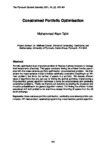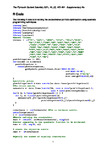Constrained Portfolio Optimisation
| dc.contributor.author | Moh Tahir, M.A. | |
| dc.date.accessioned | 2021-12-24T17:46:37Z | |
| dc.date.available | 2021-12-24T17:46:37Z | |
| dc.date.issued | 2021 | |
| dc.identifier.citation |
Moh Tahir, M.A. (2021) 'Constrained Portfolio Optimisation', The Plymouth Student Scientist, 14(2), pp. 429-464. | en_US |
| dc.identifier.uri | http://hdl.handle.net/10026.1/18510 | |
| dc.description.abstract |
Portfolio optimisation is an important problem in finance; it allows investors to manage their investments effectively. This paper considers finding the efficient frontier associated with the mean-variance portfolio optimisation (unconstrained) problem. We then extend the mean-variance model to include cardinality constraints (resulting in an NPHard problem) that limits the number of assets in a portfolio. We discuss different types of algorithms that one can use for finding the optimal portfolios, implementing a meta-heuristic genetic algorithm technique to solve the unconstrained and cardinality constrained problems. Finally, we improve our solutions by altering the crossover and mutation probabilities in the genetic algorithm method. For finding the efficient frontier associated with both problems, we examine a dataset involving 55 assets from the US stock exchange. | en_US |
| dc.language.iso | en | en_US |
| dc.publisher | University of Plymouth | en_US |
| dc.rights | Attribution 3.0 United States | * |
| dc.rights.uri | http://creativecommons.org/licenses/by/3.0/us/ | * |
| dc.subject | Mean-variance portfolio optimisation | en_US |
| dc.subject | cardinality constrained portfolio optimization | en_US |
| dc.subject | NP-Hard problem | en_US |
| dc.subject | quadratic programming | en_US |
| dc.subject | meta-heuristic | en_US |
| dc.subject | genetic algorithm | en_US |
| dc.title | Constrained Portfolio Optimisation | en_US |
| dc.type | Article | en_US |
| plymouth.issue | 2 | |
| plymouth.volume | 14 | |
| plymouth.journal | The Plymouth Student Scientist |




